This spring the National Biodiversity Data Centre and the Botanical Society of Britain and Ireland have been conducting a project, collecting records of our common spring flowers. So far this year, I’ve seen a handful of species on the list and there are some that I’ve never come across at all. In a beautiful but quiet way they’ve signalled the end of winter and the start of spring. The plant that made the biggest impression on me this year wasn’t a native plant however, but an Asian species that heralded the arrival of spring in Ireland with a spectacular fanfare. Coming into view just after crossing Belvelly Bridge onto Fota Island the treeline of Fota Arboretum was lit up by the canopy of a Magnolia campbellii covered in beautiful pink blossom.
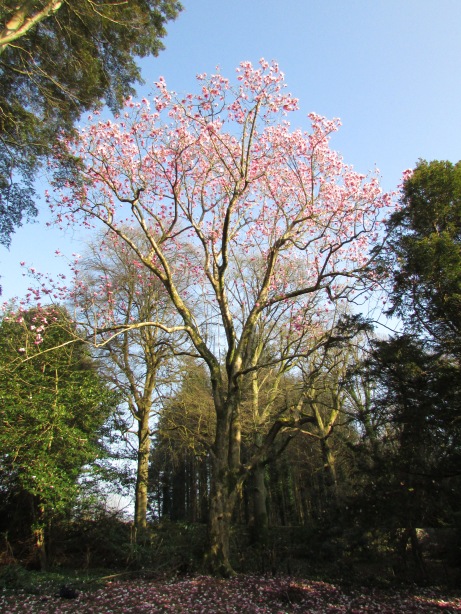
Fota Magnolia campbellii, March 2016
Magnolia campbellii first came to the attention of people on this side of the world in 1855 when it was described by renowned botanist and plant hunter, James Dalton Hooker in the book Illustrations of Himalayan Plants. In it, Hooker credits Dr. William Griffith with having “discovered” Magnolia campbellii, although considering the ancient origin of the Magnoliaceae family, dating back 95 million years in the fossil record, he was unlikely to have been the first person to come across it! Griffith died in 1845 and his notes on the tree only arrived back to England after Illustrations of Himalayan Plants was published, so it was left to Hooker to name and publicly describe it for the first time.
The era of the plant hunter has long been romanticised with the image of brave men of science risking life and limb in the pursuit of the rare and exotic. Indeed it could be a perilous career to embark upon, so it helped to have a little imperial backup to call on from time to time. On one expedition into Sikkim, Hooker was accompanied by the British Resident Minister of nearby Darjeeling, a man named Dr. Archibald Campbell. Their unauthorised arrival in Sikkim was met with a hostile reception and both men were taken prisoner. The arrival of British troops at the border was enough to secure their release and although the incident ended without further escalation it directly led to the subjugation of Sikkim into the British Empire. It was in Sikkim that Hooker first met with the tree, called in Nepali Ghoge Chanp, and he decided to honour his friend by giving it the scientific classification Magnolia campbellii.
Illustrations of Himalayan Plants featured 24 colour lithographic plates which were mostly based on drawings by Indian artists commissioned by a British civil servant in Darjeeling, James F. Cathcart. In his introduction Hooker fondly recalls his late friend: “Mr. Cathcart was an ardent amateur, a man of highly cultivated mind; […] he loved science for its own sake”. (Hooker also paid tribute to him by naming a genus of Himalayan woodland poppy in his honour. Unfortunately for Cathcart, taxonomists would later decide that the poppy belonged in another genus and Cathcartia villosa became Meconopsis villosa.) The plates were created by a great collaborator of Hooker’s, W.H. Fitch. With the benefit of Hooker’s preserved specimens and analyses, “and, by his own unrivalled skill in seizing the natural characters of plants”, Fitch depicted Magnolia campbellii beautifully in two colour plates and also at the centre of a group of flowers on the illustrated title page. Hooker described it as a “superb tree” on which “flowers are produced abundantly in April, at the end of all the branches, when the tree is as yet perfectly leafless; they vary from white to deep rose-colour, or almost crimson, and in size from six to ten inches”. Such a description along with Fitch’s artwork and the prediction that it “would no doubt prove hardy in England” must certainly have peaked the interest of the readership – which included amongst the subscribers Queen Victoria and Charles Darwin.
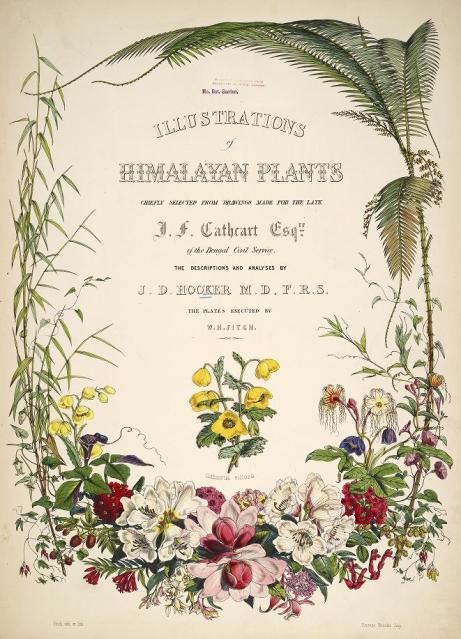
Title page of Illustrations of Himalayan Plants
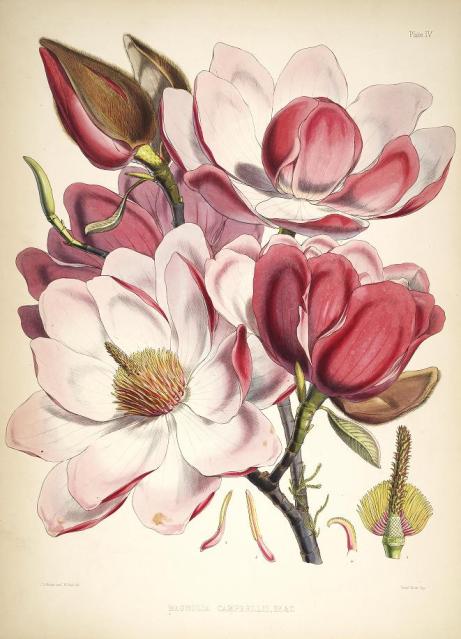
Plate 4 Illustrations of Himalayan Plants by W.H. Fitch
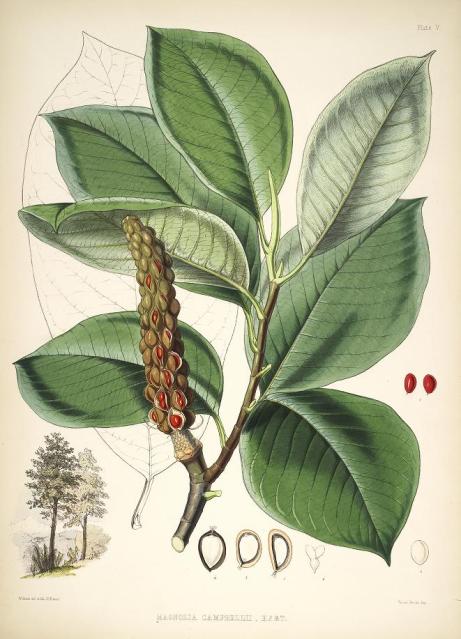
Plate 5 Illustrations of Himalayan Plants by W.H. Fitch
As promising as the tree sounded, the problem of transporting it to the other side of the world remained. Seed would seem the obvious choice but in an 1885 article in Curtis’s Botanical Magazine, Hooker wrote, “Repeated attempts have been made to introduce Magnolia Campbellii by seed, but on arrival the fleshy albumen has always been found to have decayed and killed the minute embryo.” With the scarcity of fresh water and the choice between salt exposure above deck or an absence of sunlight below, a plant’s chances of survival on a long sea voyage were slim. An invention by an English doctor named Nathaniel Bagshaw Ward was to change that. The Wardian Case was a tightly sealed, glazed wooden case. Enclosed within it, plants could photosynthesise above deck, safely protected from the elements and salt spray, and crucially the water lost by the plant as it transpired was recycled back to it after condensing on the glass. This would have been how Magnolia campbellii along with thousands of other species first arrived from across the world to Europe. Ten years after it was described in Illustrations of Himalayan Plants it was introduced to cultivation when live specimens were sent to Kew from the Calcutta Botanic Gardens. Hooker regretfully noted that, “they have proved too tender for the open air in the East of England. […] At Kew it grows well in the temperate house but has not hitherto flowered.” In Europe Magnolia campbellii had only produced flowers in the south of France, Italy and in one other place: “In Ireland, however, it has succeeded.”
In Cork, William Hugh Crawford’s name is remembered by the Crawford Art Gallery, which was built under his patronage, and also as one half of the brewing partnership Beamish and Crawford. Less well remembered is his passion for plants and the gardens he created at his home, Lakelands, where the Lee flows into Cork Harbour at Lough Mahon. In 1885, however, he became famous for growing the first Magnolia campbellii to flower in Great Britain or Ireland. Hooker wrote, “I saw a small tree of it in Mr. Crawford’s well known garden near Cork in 1878; this flowered in March of the present year, when that gentleman kindly forwarded the flower for figuring in this work.” The flower Crawford sent was featured in a colour plate, created once again by Fitch and a specimen was also preserved in the herbarium at Kew.
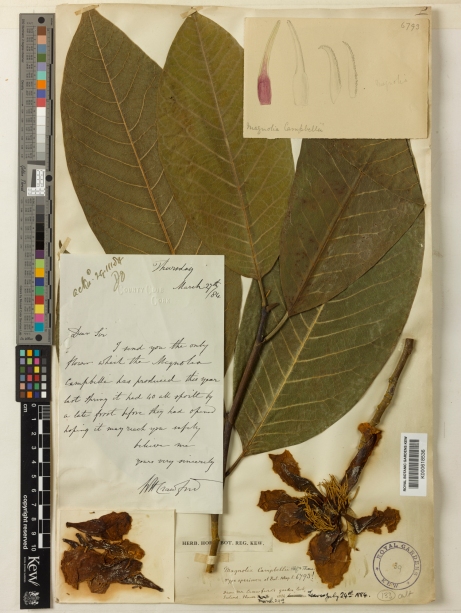
Lakelands Magnolia campbellii specimen with accompanying letter from W.H. Crawford. © copyright of the Board of Trustees of the Royal Botanic Gardens, Kew.
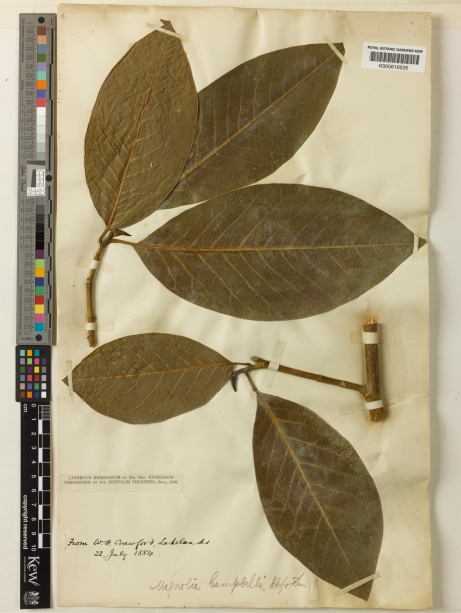
Lakelands Magnolia Campbellii specimen. © copyright of the Board of Trustees of the Royal Botanic Gardens, Kew.
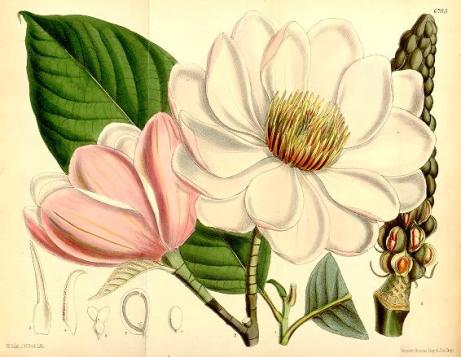
Lakelands Magnolia campbellii Curtis’s Botanical Magazine by W.H. Fitch
Despite the initial excitement about the Lakelands tree, it seems that there was a touch of disappointment that it had not quite lived up to the hype generated in Illustrations of Himalayan Plants. In 1895 it was described in The Gardener’s Chronicle as, “a pale flowered form very much inferior to that figured in the first mentioned work.” Redemption was at hand for Magnolia campbellii however, as the article reveals that ten years after the first flowering at Lakelands, “another plant has flowered at Fota Island, in another famous garden in southern Ireland, and this – a fine specimen 25 feet in height – has gloriously rich rosy-red-tinted flowers.” In notes published the same year in The Garden, William Osborne, head gardener at Fota described them: “The colour of the outside of the flower is dark rose or crimson and lighter inside, with petals of great substance. I attribute its free flowering to the abnormally dry summer here of 1894.” The owner of the Fota estate at the time was Arthur Hugh Smith Barry and it must have been a source of tremendous pride for him to have the event described as “an epoch in the calendar of successes achieved” in “that lovely and fertile domain.” As the gardener, William Osborne also had reason to be proud. The event was such a significant career milestone that when he died in 1903 it was mentioned in his obituary in The Gardener’s Chronicle and his photograph of the tree is still stored in the Kew Herbarium.
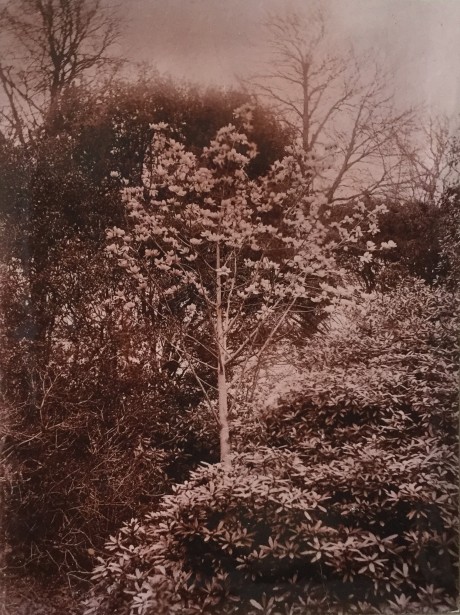
Fota Magnolia campbellii February 18th 1895 by William Osborne. © copyright of the Board of Trustees of the Royal Botanic Gardens, Kew.
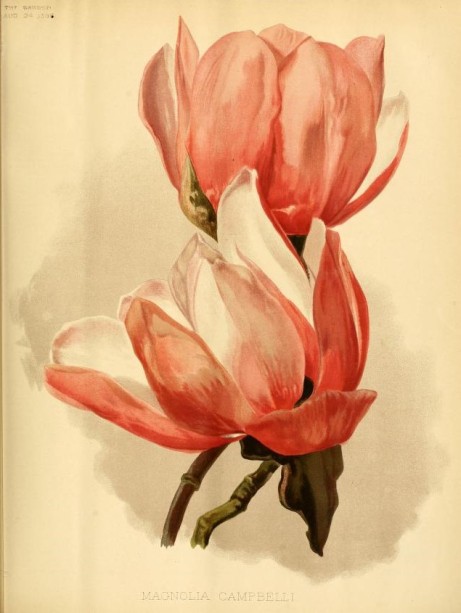
Fota Magnolia campbellii by H.G. Moon, The Garden 1895
Over the next few years some trees in the south of England began to catch up with their Irish cousins and were listed in The Trees of Great Britain and Ireland. They had flowered at Veitch’s nursery (1898), Abbotsbury (1903) and Leonardslee (1907). Another Irish tree was also on the list and once again it was a tree that had found a home in Cork Harbour, in the garden of a neighbour of the Smith Barrys, at Belgrove near Cobh. Belgrove was described in a 1901 feature in The Garden as a “richly stocked and beautiful garden” and its owner W.E. Gumbleton as a man with “all the energy and critical acumen and botanical knowledge necessary for a director of a first class botanical garden.” Magnolia campbellii first flowered there in 1902 and on March 10 1903 Gumbleton exhibited it to the the Royal Horticultural Society Floral Committee. Mr. W. Marshall in the Chair and the 24 members present voted unanimously to award it the highest award for an exhibit, the First Class Certificate.
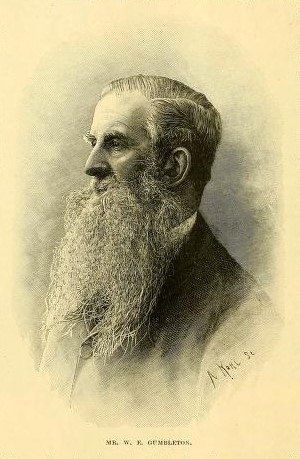
W.E. Gumbleton, The Garden 1901
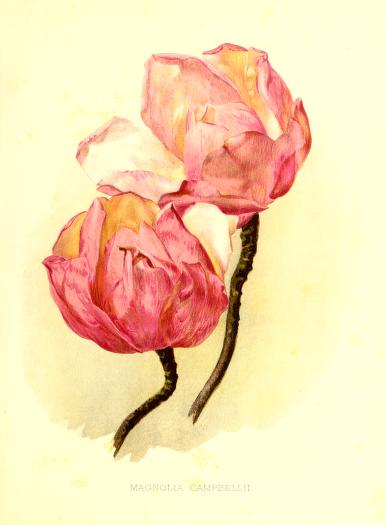
Belgrove Magnolia campbellii by H.G. Moon, Flora and Sylva 1903
In 1885 Hooker wrote that Magnolia campbellii was “growing scarce in Sikkim”. Ironically the tea industry that was started in Darjeeling by Archibald Campbell is partly to blame for its decline, as it is still being logged for building tea boxes. Thankfully, although the population trend is still decreasing, The International Union for Conservation of Nature lists it as a species of least concern and in the Sikkim Himalayas it is regenerating. The work begun by Hooker and Cathcart in recording the plant species of the Himalayas continues today with the Royal Botanic Gardens Edinburgh coordinating activities contributing to the Flora of Nepal. Closer to home the Spring Flowers Project is just one of many surveys carried out by the National Biodiversity Data Centre with the help of the public. As Hooker wrote in the introduction of Illustrations of Himalayan Plants, “Science is not yet self-supporting; it requires the countenance of amateurs no less than the severe studies of proficients to ensure its progress.”
The Magnolia campbelli at Lakelands is long gone and not much remains of the gardens there. A huge Araucaria araucana, the towering Monkey Puzzle that comes into view as you head west on the N40 after emerging from the Jack Lynch tunnel is the most prominent reminder of what once existed. There is little left of Gumbleton’s “beautiful private botanical garden” at Belgrove either. What is there is still in private ownership but is now farmland. Thankfully the Magnolia still stands and when measured in 1978 stood just shy of 21 metres. Importantly the Fota specimen is open to the public and free to visit along with all of the other magnificent trees in the arboretum. In 1984 it came in at 24 metres tall and this year put on a stunning display. In correspondence to the Gardener’s Chronicle in 1907 Gumbleton wrote, “Readers who have access to a botanical library, such as those at Kew and the British Museum should refer to the splendid portrait in Cathcart and Hooker’s Himalayan Plants […] I fear however, we shall never see the species in such excellence in our uncertain climate.” I think even he would have been impressed.
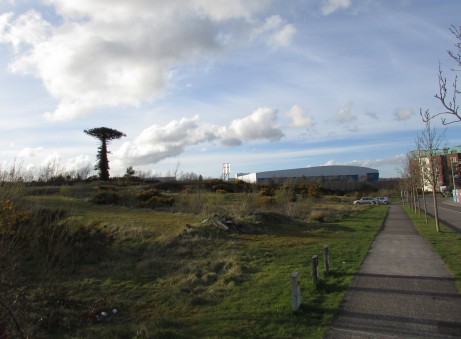
Araucaria araucana, one of the last reminders of Crawford’s garden at Lakelands, Lough Mahon
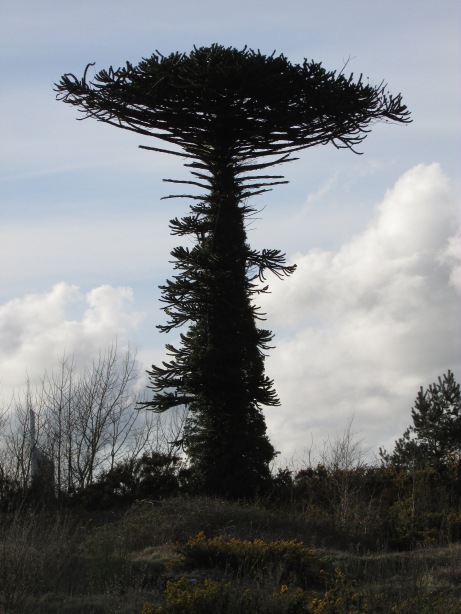
Araucaria araucana, Lakelands
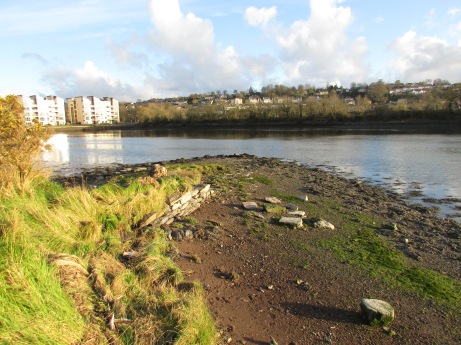
Remnants of Crawford’s Quay, Lakelands, Lough Mahon
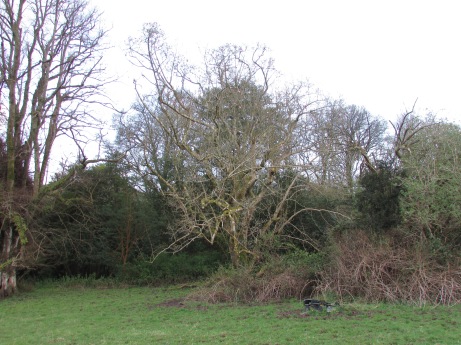
Belgrove Magnolia campbellii, April 2016
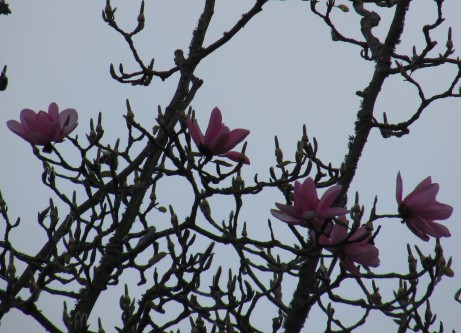
Belgrove Magnolia campbellii, April 2016
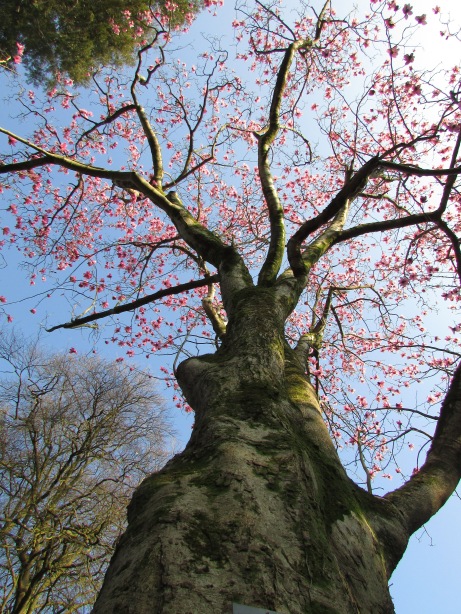
Fota Magnolia campbellii, March 2016
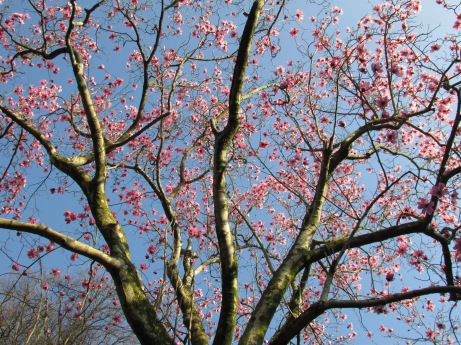
Fota Magnolia campbellii, March 2016
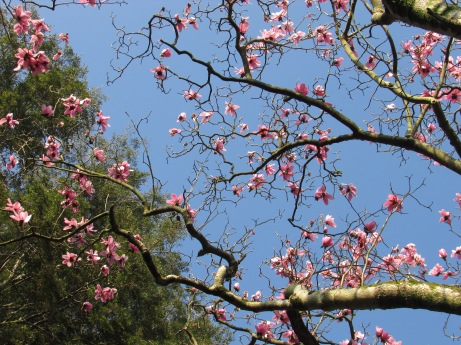
Fota Magnolia campbellii, March 2016
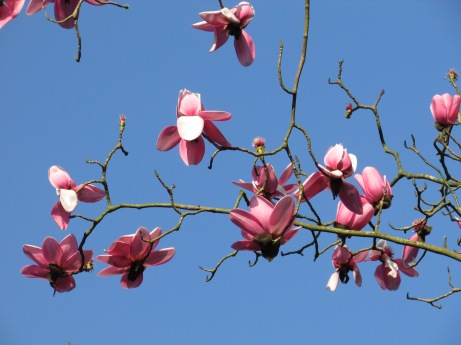
Fota Magnolia campbellii, March 2016
References
Andrews, S. (2005) Tree of the Year: Magnolia Campbellii. International Dendrology Society
B., A.C. (1903) Obituary. The Gardener’s Chronicle 34: 344
Burbidge, F.W. (1901) Gardens in Ireland. The Garden 59: 61-64
Burbidge, F.W. (1895) The Indian or Sikkim Yulan. The Garden 48: 142-143 pl. 1028
Elwes, H.J. & Henry, A. (1912). The Trees of Great Britain and Ireland.
Gumbleton, W.E. (1903) Magnolia campbellii. Flora and Sylva 2: 296-297
Gumbleton, W.E. (1907) Home Correspondence. The Gardener’s Chronicle 42: 33Hooker, J.D. (1855) Illustrations of Himalayan Plants
Hooker, J.D. (1885) Curtis’s Botanical Magazine 111: Tab. 6793
Nelson, E.C. (1979) Magnolia campbellii in County Cork. The Garden 104 (12): 495-496
Nicholson, G. (1895) The Magnolias. The Gardener’s Chronicle 17: 515-516


Pingback: Straysongs – JJ Cale – Magnolia | The Stray Sod